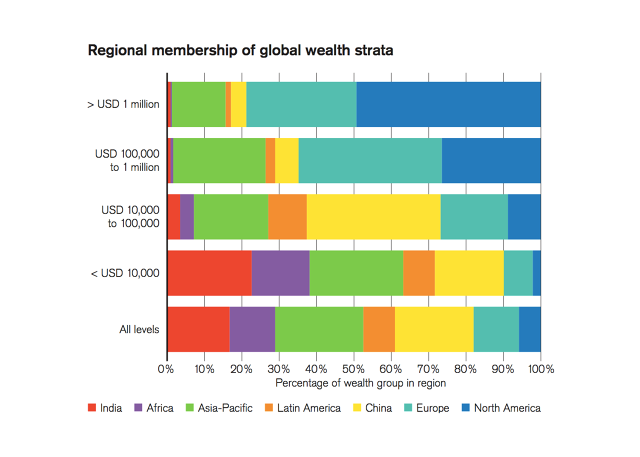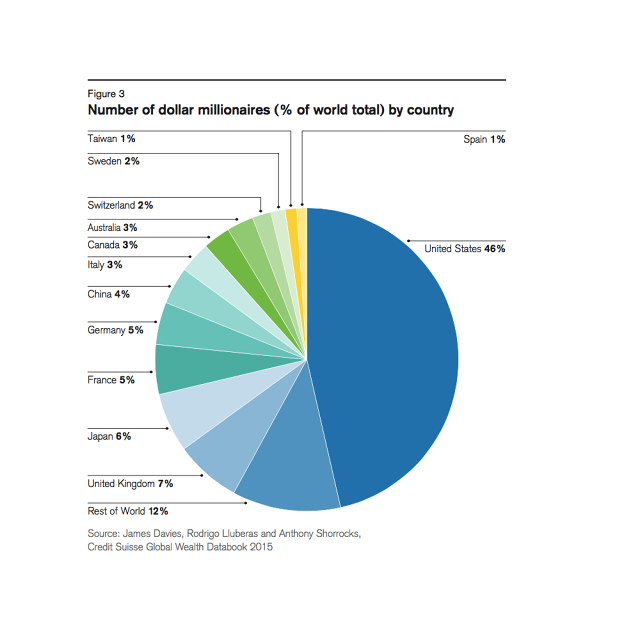On October 16, 2015, Ben Schiller writes on Fast Company:
If you’re lucky enough to be a member of the global 1%, last year was another good year to be alive (every year is pretty great, though). Your wealth bracket increased its share of global riches so that it holds just over half of global wealth, according to a new reportfrom Credit Suisse.
In the years 2000 to 2007, the richest people on Earth actually saw their proportion of global wealth fall, from 49% to 45%. But since the recession the trend has gone into reverse: The top 1% now controls 50.4% of all household wealth.

Wondering if you’re in this elite club? You’d need a total of $759,900 in assets, after debts have been subtracted. What about the top 10%? That’s a little easier: you’d only need $68,500. And the top half: Count yourself in if you have $3,210.
“While the bottom half of adults collectively own less than 1% of total wealth, the richest decile holds 87.7% of assets, and the top percentile alone accounts for half of total household wealth,” the report says. In fact, the 1% is doing better relatively speaking than the 10%, which achieved its highest wealth share back in 2000.

Credit Suisse puts the stunning rise of the 1%, and the inequality that goes with it, down to one main factor: growth in equity prices around the world. The rich are getting richer because they own things that are appreciating in value. At the same time, average wages in the U.S. and elsewhere have been stagnating: Wages now make up a record-low share of U.S. gross domestic product.

“Financial assets continue to increase in relative importance and … the rise in the [price of the U.S dollar] over the past year has given wealth inequality in the United States—which is very high by international standards—more weight in the overall global picture,” the report says. In other words, inequality here is contributing more to inequality globally speaking.
Almost three-quarters of the world (3.4 billion individuals) have wealth of $10,000 or less, while 21% are in the $10,000–$100,000 range. Still, the power of the bottom of the pyramid shouldn’t be underestimated: It amounts to $39 trillion globally.
http://www.fastcoexist.com/3052294/the-1-now-owns-half-of-all-the-wealth-in-the-entire-world
At Agenda 2000 Incorporated, the advocacy company I founded with binary economist Louis Kelso, we used 90 percent, while the Rand Corporation statistic was 98 percent, to represent the productive capital factor input to creating products and services. In concentrated capital ownership terms, we calculated back in the late 1960s that roughly 1 percent owned 50 percent of the corporate wealth with 10 percent owning 90 percent. This leaves 90 percent of the people scrambling for the last 10 percent, with them dependent on their labor worker wages to purchase capital assets. Thus, we have the great bulk of the people providing a mere 10 percent or less of the productive input. Contrast that to the less than 5 percent who own all the productive capital providing 90 percent or more of the productive input, and who initiate and oversee most of the technological advances that replace labor work by workers with capital work by the owners of productive capital assets. As a result, the trend has been to diminish the importance of employment with productive capital ownership concentrating faster than ever, while technological change makes physical capital ever more productive. Corporate decision makers know this, whether in the United States or China, or anywhere organized assemblies of people engage in production. Technology is an easier and faster way to get a job done. Because technology increases the profitability of companies throughout the world, technology always has the advantage over human labor when the costs of them are the same. But because this is not well understood, what we as a society have been doing is to continually shift the work burden from people labor to real physical capital while distributing the earning capacity of physical capital’s work (via capital ownership of stock in corporations) to non-owners through make-work job creation, minimum wage requirements, and welfare programs. Such policies do not function effectively.
In a democratic growth economy, based on Kelso’s binary economics (human and non-human productive inputs), the ownership of productive capital assets would be spread more broadly as the economy grows, without taking anything away from the 1 to 10 percent who now own 50 to 90 percent of the corporate wealth (during their lifetimes and then spread out by them to all members of their family, friends, servants and workers who helped create their fortunes, teachers, health workers, police, other public servants, military veterans, artists, the poor and the disabled). Instead, the ownership pie would desirably get much bigger and their percentage of the total ownership would decrease, as ownership gets broader and broader, benefiting EVERY citizen, including the traditionally disenfranchised poor and working and middle class. Thus, productive capital income, from full earnings dividend payouts, would be distributed more broadly and the demand for products and services would be distributed more broadly from the earnings of capital and result in the sustentation of consumer demand, which will promote economic growth and more profitable enterprise. That also means that society can profitably employ unused productive capacity and invest in more productive capacity to service the demands of a growth economy. As a result, our business corporations would be enabled to operate more efficiency and competitively, while broadening wealth-creating ownership participation, creating new capitalists and “customers with money” to support the products and services being produced.

